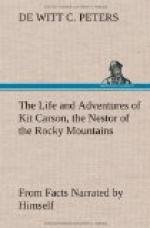The caravan had hardly launched out on its long and tedious tramp, when an accident occurred which came very near proving serious in its results. For several days the men had been greatly annoyed by wolves who appeared more than usually ravenous and bold.[2]
[Footnote 2: There are two species of these animals found on the western prairie. One is small, called the Jackal; the other much larger. The latter, or larger species, are found of various, colors, but more frequently grey. The color, however, varies with the season and often from other causes. Many of their habits are strikingly similar to those of the domestic dog, with the simple difference that the wolf is unreclaimed from his wild state. The connecting link between the prairie wolf and the domestic dog is the cur found among the Indians. The Indian cur, by a casual observer, could be easily mistaken for a prairie wolf. Near the Rocky Mountains, and in them, these animals are found of immense size; but, being cowardly, they are not dangerous. The first night a person sleeps on a prairie is ever afterwards vividly impressed upon his memory. The serenade of the wolves with which he is honored, is apt to be distinctly remembered. It is far from agreeable, and seldom fails to awaken unpleasant forebodings concerning the future; and, the idea that these fellows may be soon clearing his bones, is not very genial to the fancy. To the wolf the graveyard is anything but consecrated ground; and, if a person is very chary of his cadaver, he had better not leave it on the Western Plains. The wolf is quite choice in his viands whenever the opportunity offers, and will, at any time, leave the carcass of an Indian for that of a white man. Old frontiersmen, speaking of the wolves, usually style them as “their dogs;” and, after a night when these animals have kept up an incessant barking, they will express wonder by asking what has been disturbing “their hounds.” The flesh of the mountain wolf, when cooked, has something of the smell and taste of mutton, but it is very rank.]




